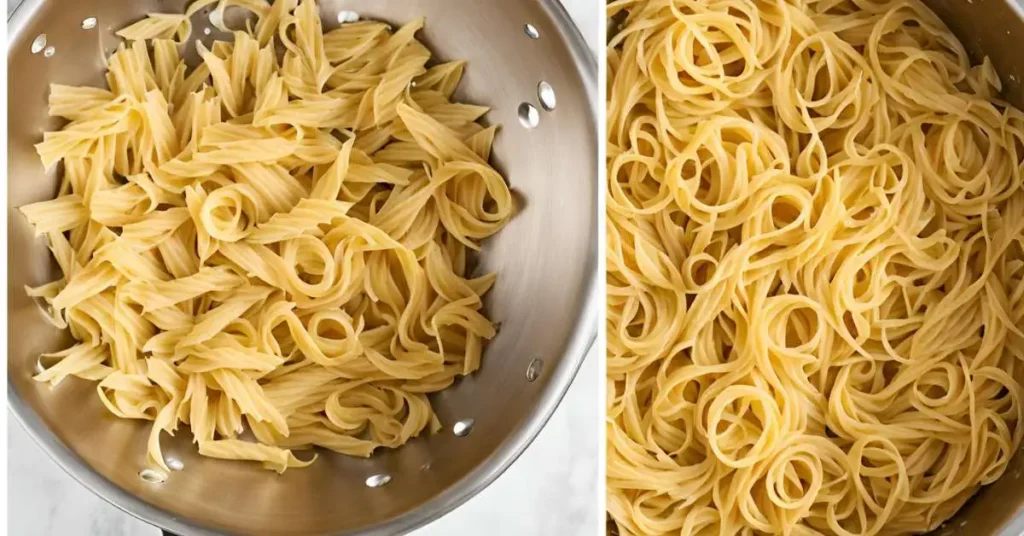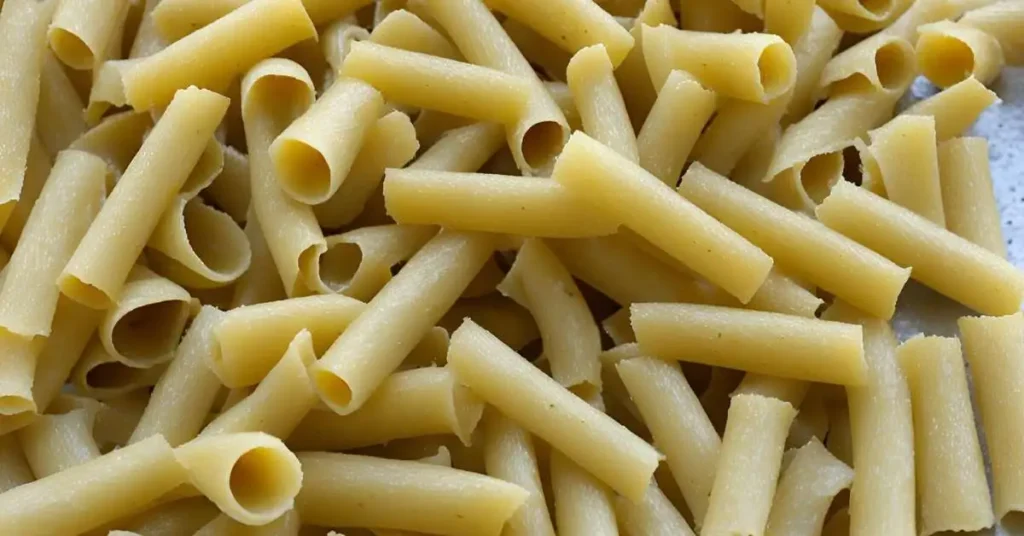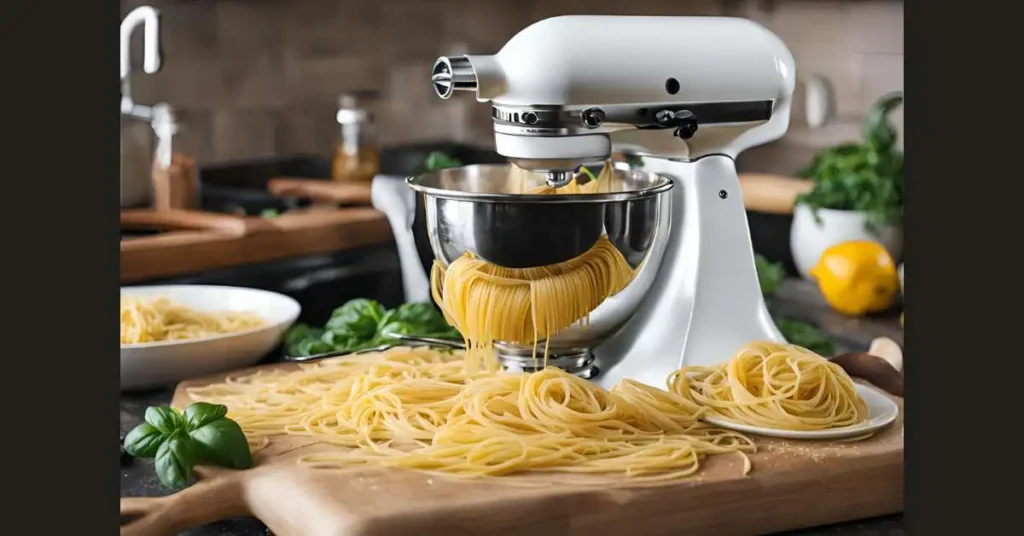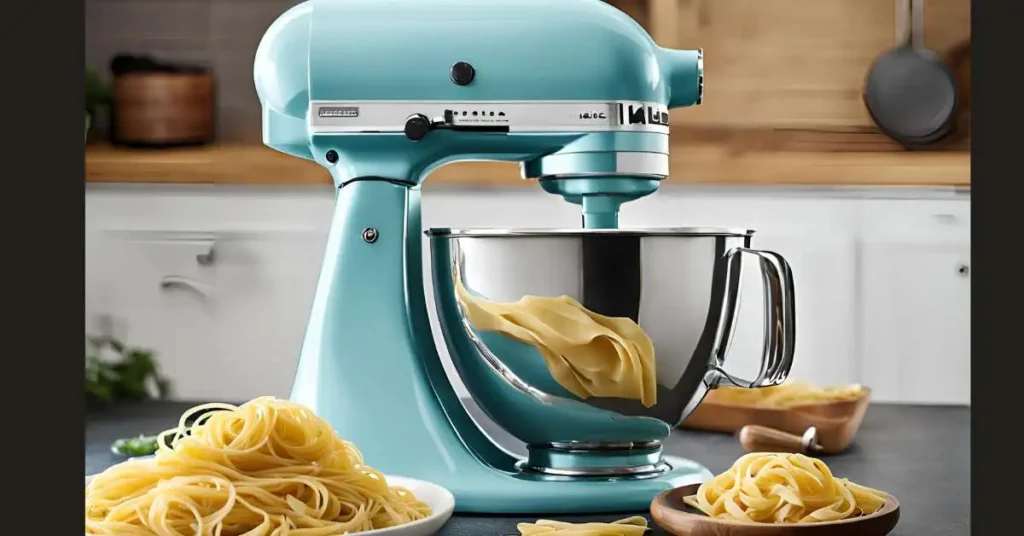Hey there! Have you ever wondered how to make a delicious pasta dish at home?
Personally, I think cooking should be fun and easy, don’t you?
Today, let me share with you a simple recipe for KitchenAid pasta that’s perfect for anyone looking to enjoy a homemade meal.
Table of Content
- 1 How did I learn this dish?
- 2 Recipe
- 3 Method of Instruction
- 4 Recipe Video
- 5 Servings
- 6 Tips
- 6.1 1. Experiment with Different Pasta Shapes
- 6.2 2. Use Fresh Herbs for Vibrant Flavor
- 6.3 3. Toast Your Spices and Nuts
- 6.4 4. Balance Sweetness with Acid
- 6.5 5. Finish with a Drizzle of Quality Olive Oil
- 6.6 6. Grate Fresh Parmesan at the Table
- 6.7 7. Season Pasta Water Generously
- 6.8 8. Reserve Pasta Water for Sauce
- 6.9 9. Layer Flavors with Sauteed Vegetables
- 6.10 10. Garnish with Fresh Citrus Zest
- 6.11 Ingredient Substitutes
- 6.11.1 1. I Swap Beef with Halal Chicken or Turkey
- 6.11.2 2. My Go-To: Plant-Based Proteins
- 6.11.3 3. I Opt for Halal Turkey or Beef Bacon
- 6.11.4 4. Lentils for a Hearty Touch
- 6.11.5 5. Mushrooms Add Umami
- 6.11.6 6. Non-Alcoholic Wine or Broth for Depth
- 6.11.7 7. Coconut Milk for Creaminess
- 6.11.8 8. Agave Nectar or Maple Syrup for Sweetness
- 6.11.9 9. Greek Yogurt for Creamy Sauces
- 6.11.10 10. Nutritional Yeast for Cheesy Flavor
- 7 FAQ’S
- 7.1 How does the KitchenAid pasta attachment work?
- 7.2 Does KitchenAid come with a pasta maker?
- 7.3 What are the three KitchenAid attachments?
- 7.4 Can you wash KitchenAid pasta attachment?
- 7.5 How to fix dough stuck in KitchenAid pasta attachment?
- 7.6 How do I use my KitchenAid attachment?
- 7.7 How long to dry pasta?
- 7.8 What flour to use for pasta?
- 7.9 Is homemade pasta healthier?
- 8 Remarks
How did I learn this dish?
You know, learning this dish was quite an adventure for me. I don’t know how many times I experimented in the kitchen, trying to get it just right. But I can tell you that every trial and error taught me something new about flavors and techniques. It’s amazing how a simple recipe can bring so much joy and satisfaction, right?
I think what I love most about sharing recipes like this one is making cooking feel approachable and enjoyable for everyone. I want to create dishes that are not just tasty but also easy to make at home. That’s why I’m excited to post more recipes that are friendly and relatable, inviting you all to join in and discover the joy of cooking with me.
Now, about this recipe. Its origin dates back to the 15th century in Genoa, Italy, where it was first created by local cooks. This dish is more than just a meal; it’s a connection to the rich culinary heritage of Italy. It’s amazing how food can tell stories and bring people together, don’t you think?
Recipe
Let’s transform simple ingredients into a delightful pasta creation that promises to elevate your dining experience!
Category: Main Course
Cuisine: Italian
Serving: 6 servings
Prep Time: Approximately 30 minutes
Cook Time: Approximately 5-7 minutes
Calories: 300-400 calories per serving
Ingredients:
| Pasta (such as spaghetti or penne) |
| Pesto sauce |
| Peas (fresh or frozen) |
| Parmesan cheese |
| Garlic |
| Olive oil |
| Salt |
| Black pepper |
Equipment:
| KitchenAid stand mixer with pasta attachment (pasta roller and cutter) |
| Large mixing bowl |
| Measuring cups and spoons |
| Rolling pin (if not using KitchenAid pasta attachment) |
| Knife and cutting board |
| Pot for boiling water |
| Colander |
Method of Instruction
- Prepare the Dough: I start by combining flour and salt in a large bowl. Create a well in the center and add the eggs, olive oil, and water. Gradually mix the wet and dry ingredients until a dough forms. Knead it for about 5-7 minutes until smooth and elastic.
- Rest the Dough: Wrap the dough in plastic wrap and let it rest at room temperature for about 30 minutes. This helps the gluten relax, making the dough easier to roll out.
- Rolling the Dough: After resting, divide the dough into smaller sections. Using a pasta roller attachment on your KitchenAid, start with the widest setting and roll the dough through. Fold it in half and roll again, gradually reducing the thickness until desired thinness is achieved.
- Cutting the Pasta: Switch to the pasta cutter attachment on your KitchenAid or use a knife to cut the rolled-out dough into your desired pasta shape—fettuccine, spaghetti, or even ravioli squares.
- Cooking the Pasta: Bring a large pot of salted water to a boil. Add the fresh pasta and cook for 2-4 minutes or until al dente. Fresh pasta cooks much quicker than dried, so keep an eye on it.
- Serve and Enjoy: Drain the pasta and toss it with your favorite sauce or simply drizzle with olive oil and sprinkle with grated cheese. Serve immediately and savor the homemade goodness!
Recipe Video
Simple Kitchenaid Pasta Recipe
This is the video about how to make Simple Kitchenaid Pasta Recipe at home.
Author:
Rated: 4.9 of 5.0 from 379 reviews.
You May Also Like
Servings
I love exploring new ways to present pasta dishes because they can turn an ordinary meal into a delightful experience. It’s not just about food—it’s about creating moments that bring joy and satisfaction to those who enjoy my cooking.
- 1. Pasta Bowls with Fresh Basil I start with deep pasta bowls and garnish each serving with vibrant, aromatic fresh basil. It adds a burst of color and freshness that elevates the dining experience.
- 2. Family-Style Pasta Platter For gatherings, I opt for a large platter filled with the pasta. It encourages sharing and makes everyone feel involved in the meal, creating a warm and communal atmosphere.
2. Family-Style Pasta Platter For gatherings, I opt for a large platter filled with the pasta. It encourages sharing and makes everyone feel involved in the meal, creating a warm and communal atmosphere. - 3. Pasta Salad with Mediterranean Flavors Chilling the pasta and tossing it with cherry tomatoes, olives, feta cheese, and a tangy lemon vinaigrette transforms it into a refreshing pasta salad perfect for summer gatherings.
- 4. Pasta with Creamy Mushroom Sauce I love preparing a creamy mushroom sauce with garlic and cream to coat the pasta. It’s comforting and indulgent, perfect for cozy nights at home.
- 5. Pasta Carbonara with Crispy Pancetta One of my go-to classics is pasta carbonara. The combination of eggs, Parmesan cheese, and crispy pancetta tossed with pasta creates a creamy and savory dish that never fails to impress.
- 6. Pasta Primavera with Seasonal Vegetables Sauteing seasonal vegetables like bell peppers and zucchini and tossing them with pasta and a light olive oil dressing is a great way to celebrate fresh produce and add vibrant colors to the dish.
- 7. Baked Pasta Casserole Layering the pasta with marinara sauce, ricotta cheese, and mozzarella and baking it until bubbly and golden creates a comforting and satisfying pasta casserole that’s perfect for family dinners.
- 8. Pesto Pasta with Grilled Chicken Mixing pasta with homemade pesto sauce and serving it alongside juicy grilled chicken breasts makes for a balanced and flavorful meal that’s packed with protein.
- 9. Spicy Arrabbiata Pasta I enjoy making a spicy Arrabbiata sauce with tomatoes, garlic, and red chili flakes to toss with pasta. It adds a fiery kick and robust flavor that excites the taste buds.
- 10. Pasta Stir-Fry with Asian Twist Stir-frying pasta with mixed vegetables, soy sauce, and sesame oil and garnishing it with green onions and sesame seeds offers a delightful Asian-inspired twist to pasta night.
Tips
1. Experiment with Different Pasta Shapes
When choosing pasta, don’t just stick to the classics like spaghetti and penne. Explore shapes like fusilli, farfalle, or orecchiette. Each shape holds sauce differently, creating unique texture experiences.
2. Use Fresh Herbs for Vibrant Flavor
Incorporate fresh herbs like basil, parsley, or mint into your pasta dishes. They add a burst of flavor and aroma that enhances the overall taste.
3. Toast Your Spices and Nuts
Before adding them to your dish, toast spices like cumin or coriander seeds and nuts like pine nuts or almonds. This simple step intensifies their flavors and adds depth to your pasta sauce.
4. Balance Sweetness with Acid
When making tomato-based sauces, balance the sweetness of the tomatoes with a splash of balsamic vinegar or a squeeze of lemon juice. It elevates the flavors and adds a pleasant tang.
5. Finish with a Drizzle of Quality Olive Oil
After tossing your pasta with sauce, finish it off with a drizzle of extra virgin olive oil. It not only adds richness but also enhances the flavors of the dish.
6. Grate Fresh Parmesan at the Table
Instead of mixing Parmesan cheese directly into the pasta, serve it on the side for guests to grate themselves. It adds a touch of elegance and ensures the cheese retains its freshness.
7. Season Pasta Water Generously
Season the water generously with salt before cooking pasta. It flavors the pasta from within and enhances its taste, making a noticeable difference in the final dish.
8. Reserve Pasta Water for Sauce
Before draining the cooked pasta, reserve a cup of pasta water. This starchy liquid helps to emulsify and thicken sauces, creating a silky texture and binding flavors together.
9. Layer Flavors with Sauteed Vegetables
Sautee vegetables like bell peppers, mushrooms, or spinach separately before adding them to your pasta. This builds layers of flavor and ensures each ingredient retains its unique taste.
10. Garnish with Fresh Citrus Zest
Before serving, zest a lemon or lime over the pasta. The citrus zest adds a bright, refreshing note that complements the richness of the pasta sauce.
Ingredient Substitutes
1. I Swap Beef with Halal Chicken or Turkey
When a recipe calls for beef, I often substitute it with halal chicken or turkey. They offer a leaner option without compromising on flavor.
2. My Go-To: Plant-Based Proteins
For a vegetarian twist, I substitute meat with plant-based proteins like tofu or chickpeas. They add texture and are packed with nutrients.
3. I Opt for Halal Turkey or Beef Bacon
Instead of pork bacon, I use halal turkey or beef bacon. They provide the same smoky flavor and crisp texture without any pork content.
4. Lentils for a Hearty Touch
In place of ground meat, I use cooked lentils. They’re hearty, nutritious, and absorb flavors well, making them perfect for pasta sauces.
5. Mushrooms Add Umami
I substitute meat with finely chopped mushrooms. They add a savory umami flavor and a meaty texture that complements pasta dishes beautifully.
6. Non-Alcoholic Wine or Broth for Depth
When a recipe calls for wine, I substitute it with non-alcoholic wine or vegetable broth. They add depth and enhance flavors without the alcohol content.
7. Coconut Milk for Creaminess
Instead of dairy cream, I use coconut milk. It’s creamy, dairy-free, and adds a subtle sweetness that pairs well with spicy or tangy sauces.
8. Agave Nectar or Maple Syrup for Sweetness
For recipes that require honey, I substitute it with agave nectar or maple syrup. They add a natural sweetness and depth of flavor to pasta sauces.
9. Greek Yogurt for Creamy Sauces
In place of heavy cream, I use Greek yogurt. It’s rich, tangy, and gives sauces a creamy texture without the heaviness of traditional cream.
10. Nutritional Yeast for Cheesy Flavor
To add a cheesy flavor without dairy, I sprinkle nutritional yeast over pasta dishes. It’s savory, packed with vitamins, and complements many pasta recipes.v
FAQ’S
How does the KitchenAid pasta attachment work?
The KitchenAid pasta attachment works by mixing and kneading the dough, then extruding it through different pasta shaping plates to create various pasta shapes.
Does KitchenAid come with a pasta maker?
KitchenAid mixers typically do not come with a pasta maker attachment included. It needs to be purchased separately.
What are the three KitchenAid attachments?
The three main KitchenAid attachments are the pasta roller and cutters, food grinder, and slicer/shredder.
Can you wash KitchenAid pasta attachment?
Yes, you can wash the KitchenAid pasta attachment. It’s recommended to disassemble it and hand wash the parts in warm, soapy water.
How to fix dough stuck in KitchenAid pasta attachment?
If dough gets stuck, turn off the mixer, disassemble the attachment, clean out any stuck dough, and ensure all parts are properly aligned before reassembling.
How do I use my KitchenAid attachment?
Attach the desired accessory, prepare your dough according to the recipe, then follow the specific instructions for each attachment to create pasta, grind meat, or slice/shred ingredients.
How long to dry pasta?
Fresh pasta typically needs 30 minutes to 2 hours to dry, depending on humidity and thickness. Hang it on a drying rack until firm but not brittle.
What flour to use for pasta?
Use durum wheat flour, semolina flour, or a combination for traditional pasta. All-purpose flour or gluten-free flour blends can also be used for different textures.
Is homemade pasta healthier?
Homemade pasta can be healthier than store-bought, as you control the ingredients. It often has fewer additives and can be made with whole grains for added nutrition.
Remarks
Explore the joy of homemade pasta, crafted with love and simplicity. Elevate your meals with each delicious bite, and savor the satisfaction of creating something truly special in your own kitchen.



